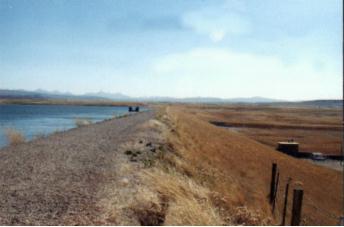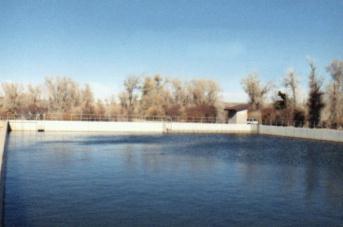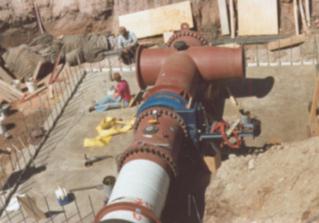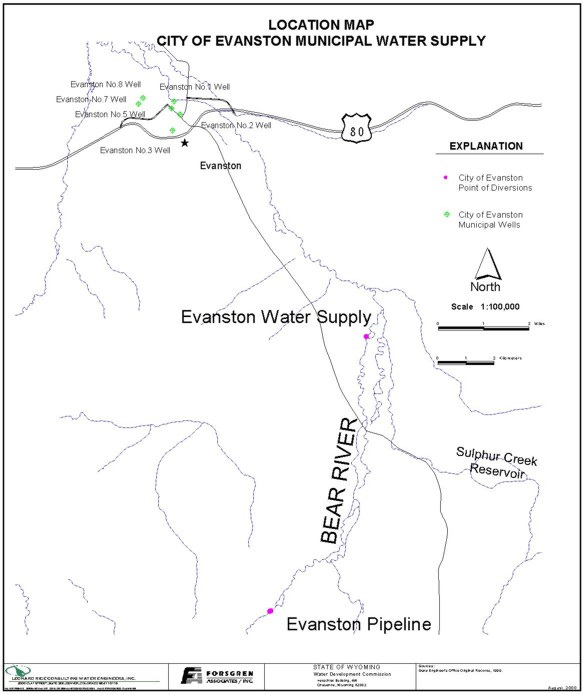Wyoming State Water Plan
Wyoming State Water Plan
Wyoming Water Development Office
6920 Yellowtail Rd
Cheyenne, WY 82002
Phone: 307-777-7626

Wyoming Water Development Office
6920 Yellowtail Rd
Cheyenne, WY 82002
Phone: 307-777-7626



| SUBJECT: |
Appendix J Municipal Water Use - City of Evanston |
| PREPARED BY: | Bear River Basin Planning Team |
Introduction: The City of Evanston is located in Uinta County in the southwest corner of Wyoming. In the past, the city's economy (and population) has been largely driven by natural resource industries, particularly oil and gas production. As a result, the Evanston economy has cycled through boom and bust periods. Evanston's population leveled off during the 1980's and has grown modestly through the 1990's.
Evanston embarked on a massive water supply project in 1988. This project was completed in 1990 and included:
 Sulphur Creek Dam |
 Evanston Intake setlling basin on the Bear River |
Following these projects, Evanston no longer relied on their wells to meet normal system demands.
| Construction Photo of Evanston's 36-inch steel transmission pipeline at junction of Sulphur Creek pipeline, Bear River pipeline, and treatment plant feed line |
 |
Service Area Population: Approximately 12,200. Service connections are as follows:
Customer Type Connections ¾-inch Residential 3060 1-inch Commercial 111 1.5-inch Commercial 63 2-inch Commercial 89 4-inch Commercial 28 6-inch Commercial 13 Senior Discount 418 TOTAL 3782 ConnectionsWater Supply: As indicated above, Evanston primarily relies on treated surface water from the Bear River and Sulphur Creek Reservoir. The current limitation in Evanston's domestic water supply is their water treatment plant with a design capacity of 8 MGD. At times, the plant is capable of producing up to 9 MGD. The city is currently working on a project to double the design capacity of the treatment plant to 16 MGD.
In order to reduce demands on the water treatment plant, Evanston has recently completed the construction of an 18-inch raw water transmission pipeline for irrigating parks, the Purple Sage Golf Course, school grounds, etc. That pipeline has a design capacity of approximately 7500 GPM. The city also owns and maintains several ground water wells as follows:
Reported Well Name Depth Capacity Quality Evanston #1 (River Well) 185 ft 600 GPM High TDS Evanston #2 (Front St Well) 65 370 High TDS Evanston #3 (Football Field Well) 76 300 N/A – Irr. Evanston #5 (Anderson Park well) 623 530 N/A – Irr. Evanston #7 (Golf Course Well) 600 250 Not in service Evanston #8 (Amoco Well) 516 530 High TDS Peart #1 (Carpenter Well) 100 600 TOTAL 3180 GPM

Water Treatment: Conventional Water Treatment Plant with 8 MGD design capacity. Historically, the plant has been able to deliver up to 9 MGD during periods of low turbidity.
Finished Water Storage:
Location Size (MG) Treatment Plant 3.0 (3 tanks) Twin Ridge 1.0 Aspen Grove 1.08 Brook Hollow 0.5 Red Mountain 0.25 TOTAL 5.83 MGWastewater Treatment / Discharge: Evanston utilizes a mechanical water treatment plant that discharges into the Yellow Creek tributary of the Bear River. Recorded average wastewater effluent for the past 7 years (1993-1999) was 1.41 MGD (4.33 AFD). Average annual wastewater effluent is 504 MG or 1,547 acre-feet.
Monthly Water Rates: $4.40 / month base rate plus $1.48 per 1000 gallons use. Monthly bill for the use of 20,000 gallons = $34.00.
Annual Water Use: (based on 1999 treatment plant meter records)
Per Capita Use: (average annual gallons per capita per day)
Recorded Peak Day Demand: (based on 1999 treatment plant meter records)
Present peak demand is supply limited. It is anticipated that per capita demand will increase with the construction of a treatment plant expansion (currently under design). The city is also in the process of constructing a 9-hole golf course expansion that will increase demands by approximately 1.1 acre-ft per day during the irrigation season (110 acre-ft annually)
Water Supply System Capacity:
Municipal Water Rights:
Surface Water Source Proof No. Priority Appropriation
Bear River (UPRR) 8600 1869 0.60 CFS
Bear River 8606 1875 4.00
Bear River 8608 1875 0.33
Bear River 8610 1875 0.505
Bear River 8705 1893 3.00
Slough of Bear River
(Dunford Ditch) 8797 1896 0.37
Bear River (Anderson Ditch) 8934 (Enl) 1901 0.85
Bear River (UPRR) 8728 1902 0.27
Bear River 14607 1911 2.89 (Fish)
Bear River 14608 1911 0.00 (Fish)
Bear River
(Rocky Mtn. Ditch) 16326 (Enl) 1914 0.69
Bear River 17075 (Enl) 1915 0.685
Bear River 21089 (Enl) 1933 0.25
Bear River (winter) 31585 1974 7.55
Reservoir Diversion 35890 1982 0.00
Reservoir 35834 (Enl) 1982 0.00
Reservoir 35889 (Enl) 1988 0.00
TOTAL SUMMER 11.55 CFS
TOTAL WINTER 19.10 CFS
Permit
Well Source Number Priority Appropriation
Evanston #1 (River Well) P425C 1934 800 GPM
Evanston #2 (Front St Well) P426C 1939 500
Evanston #3 (Football Field Well) P120C 1951 300
Evanston #5 (Anderson Park well) P588W 1961 1200
Evanston #7 (Golf Course Well) P7141W 1970 Not Adjudicated
Evanston #8 (Amoco Well) P589W 1977 500
Peart #1 (Carpenter Well) P410C 1954 1570
TOTAL 4870 GPM
(10.85 CFS)
Planned Future System Changes:
As indicated above, the City of Evanston is presently in the design phase of an 8 MGD expansion to their water treatment plant. The expanded plant should be on line in 2002. In addition, the city has recently completed construction of an 18-inch raw water line used for irrigation of parks, etc. This line is intended to reduce demands on the water treatment plant, but is not anticipated to impact overall water consumption in the city.
Evanston is also in the process of constructing a 9-hole golf course expansion that will increase demands by approximately 1.1 acre-ft per day during the irrigation season (110 acre-ft annually)
References:
a) Sunrise Engineering, Inc., Evanston Water System Master Plan Level II Study, November 1997
b) Forsgren Perkins / Rollins, Brown & Gunnell, Upper Bear River Drainage Water Resource Investigation, March 1984